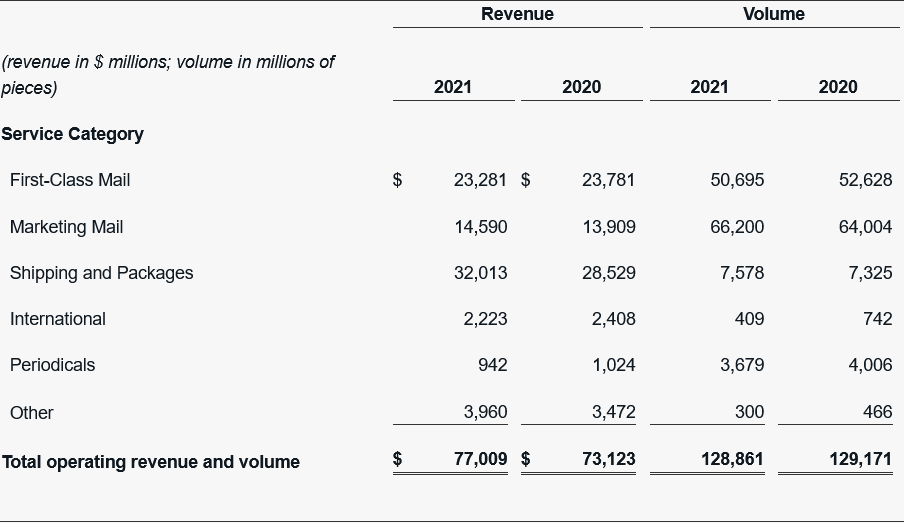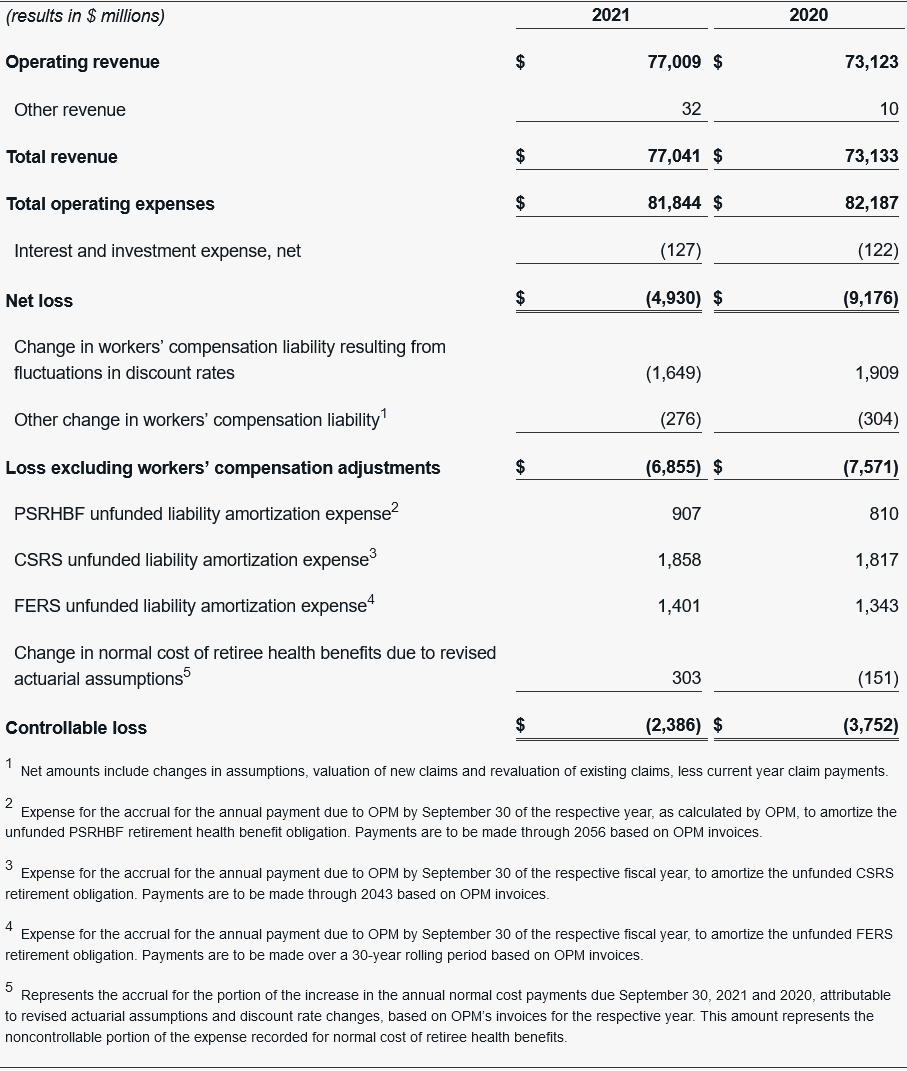WASHINGTON - The U.S. Postal Service today announced its financial results for the 2021 fiscal year ended September 30, reporting an adjusted loss of $6.9 billion for 2021, compared to an adjusted loss of $7.6 billion for 2020. This excludes non-cash workers' compensation adjustments for the impacts of actuarial revaluation and discount rate changes, which are outside of management's control. On a U.S. generally accepted accounting principles basis, the Postal Service had a net loss of $4.9 billion for 2021, compared to a net loss of $9.2 billion for 2020.
The Postal Service's operating revenue was $77.0 billion for 2021, an increase of $3.9 billion, or 5.3 percent, compared to the prior year.
Service performance continued to improve during the year, with the Postal Service reporting its strongest service performance for all mail categories since the previous year. Service performance improvements are largely the result of significant organizational focus on implementing core elements of the Delivering for America plan. The Postal Service has made network infrastructure investments, such as the installation of new package processing equipment, and has increased its leased space and workforce, to meet customers' evolving needs ahead of the 2021 holiday season and beyond.
“We are aggressively implementing our Delivering for America transformation plan and making solid progress in service and operational performance, and in enterprise-wide automation investments that have dramatically expanded our capacity to process and deliver holiday package volume for the nation,” said Postmaster General and CEO Louis DeJoy. “Despite the magnitude of our financial challenges, we are making encouraging progress in correcting the long-term imbalance in postal revenues and expenses, and we expect to see continued improvement as we fully implement the Delivering for America plan, which includes making meaningful progress towards meeting or exceeding 95 percent on-time service performance for all mail and shipping products, which we will achieve once all the elements of the plan are implemented.”
In addition to the aggressive steps that management is undertaking, which are already producing positive results, postal reform legislation is also an integral part of the Postal Service's recovery plan that is critical to ensuring financial self-sufficiency.
Shipping and Packages revenue increased $3.5 billion, or 12.2 percent, on volume growth of 253 million pieces, or 3.5 percent, largely driven by the surge in e-commerce resulting from the pandemic and record holiday volume. This surge has begun to abate as the economy continues to recover and market competition intensifies; however, Shipping and Packages volume remain higher than pre-pandemic levels.
Marketing Mail revenue increased $681 million, or 4.9 percent, compared to the prior year, on volume growth of approximately 2.2 billion pieces, or 3.4 percent. Marketing Mail experienced steep volume declines at the onset of the pandemic last year. The measured growth in Marketing Mail is a result of the low volume in the prior year due to the pandemic. While it has been rebounding as the economy continues to recover, Marketing Mail volume remains lower than pre-pandemic levels. Marketing Mail also benefited during 2021 from the higher volume of political and election mail associated with the calendar year 2020 general election season.
These increases in revenue were partially offset by a decrease in First-Class Mail revenue of $500 million, or 2.1 percent, compared to the prior year, with a volume decline of 1.9 billion pieces, or 3.7 percent. This decrease is reflective of the continuing migration from mail to electronic communication and transaction alternatives, which has been exacerbated by the pandemic.
The pandemic has significantly transformed the mix of mail and packages processed through the Postal Service's network and the Postal Service anticipates that its volumes and mix will not return to pre-pandemic levels. Despite these declines in mail, the most profitable revenue stream, and growth in Shipping and Packages, the most labor-intensive revenue stream, the Postal Service continues to grow its revenue through optimization of its pricing strategies and effective use of its pricing authority, as outlined in the Delivering for America plan.
Compensation and benefits expense increased $1.4 billion, or 2.8 percent, from the prior year, primarily due to contractual wage increases and additional work hours associated with the higher packages volume. Compensation and benefits expense is also impacted by the size and composition of the workforce, as the Postal Service continues to transition employees to permanent positions and add employees in line with the Delivering for America plan and operational needs. Transportation expense increased $838 million, or 9.5 percent, from the prior year, primarily due to higher highway transportation costs as a result of an increase in miles driven and higher average diesel fuel rates.
The other operating expense increases included a retiree health benefits expense increase of $450 million, or 9.7 percent, and a retirement benefits expense increase of $412 million, or 5.9 percent, from the prior year, due to the impact of changes in discount rates, which are outside of management’s control. Retirement benefits expense also increased due to higher pension contribution rates, as established by the Office of Personnel Management (OPM).
However, a workers' compensation expense decrease of $3.5 billion, compared to the prior year, resulting from changes in discount rates, which are outside of management's control, resulted in lower total operating expenses of $343 million, or 0.4 percent, compared to the prior year.
"We have continued to serve the American people, adapting to efficiently manage the significant growth in package volume, especially during our peak season," said Chief Financial Officer Joseph Corbett. "Despite the annual loss, we are making progress on key initiatives in the Delivering for America plan, which will allow us to generate enough revenue to cover operating costs and invest in the business while providing our customers and the country with the reliable service they expect and deserve."
FY 2021 Operating Revenue and Volume by Service Category Compared to Prior Year
The following table presents revenue and volume by category for the years ended September 30, 2021 and 2020:

Selected FY 2021 and 2020 Results of Operations and Controllable Loss
This news release references loss excluding workers' compensation adjustments, which is not calculated and presented in accordance with accounting principles generally accepted in the United States (GAAP). Loss excluding workers' compensation adjustments is defined as net loss adjusted for workers’ compensation expenses caused by actuarial revaluation and discount rate changes, which are outside of management’s control.
This news release also references controllable loss, which is not calculated and presented in accordance with GAAP. Controllable loss is defined as net loss adjusted for items outside of management’s control and non-recurring items. These adjustments include workers’ compensation expenses caused by actuarial revaluation and discount rate changes, expenses caused by the actuarial revaluation of Postal Service Retiree Health Benefits Fund (PSRHBF), and the amortization of the PSRHBF, Civil Service Retirement System (CSRS) and Federal Employee Retirement System (FERS) unfunded liabilities, which can fluctuate due to projected interest rates and inflation.
The following table presents selected results of operations, reconciles GAAP net loss to loss excluding worker's compensation adjustments and to controllable loss and illustrates the loss from ongoing business activities without the impact of non-controllable items for the years ended September 30, 2021 and 2020:

Financial results in the Form 10-K are available at http://about.usps.com/what/financials/.
Forward-Looking Statements
Forward-looking statements contained in this release represent the Postal Service's best estimates of known and anticipated trends believed relevant to future operations. However, actual results may differ significantly from current estimates. Certain forward-looking statements included in this release use such words as “may,” “will,” “could,” “expect,” “believe,” “plan,” “estimate,” “project,” or other similar terminology. These forward-looking statements, which involve a number of risks and uncertainties, reflect current expectations regarding future events and operating performance as of the date of this report. These risks include, but are not limited to, the effects of COVID-19 on the Postal Service's business, financial condition, and results of operations. The Postal Service has no obligation to publicly update or revise any forward-looking statements, whether as a result of new information, future events, or otherwise.











